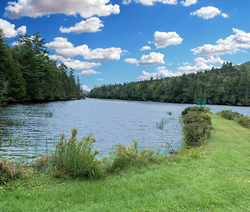
Roadside Springs: Are they safe?
The Maine CDC Drinking Water Program (DWP) does not recommend drinking water from an unregulated roadside spring.
A natural spring occurs where groundwater flows to the surface of the ground. Springs are typically located in places like a cut in a hillside, the base of a slope, or a low-lying area. In general, water from a spring is more susceptible to microbial (bacteria and viruses) contamination than water from a properly installed and maintained drilled well.
Water from a spring is in contact (or near contact) with the ground surface, exposing it to potential contaminants from the surrounding land. Water from a drilled well is typically better protected from contamination by a properly installed and sealed well casing. Also, the water flowing into a well usually follows a deeper and longer flow path where bacteria cannot survive, and the water has more time to be naturally filtered by the aquifer materials.
Please note that even if the water looks clean at a spring collection point, there could be bacteria, chemicals, parasites, and/or other contaminants present. Ingestion of any of these contaminants can cause health issues. For example, drinking water contaminated with E. Coli bacteria may result in illness including severe diarrhea, cramps, nausea, headaches, or in some cases a life-threatening condition. Children under five years of age, those with compromised immune systems, and the elderly are particularly susceptible to waterborne illnesses.
A small number of springs are regulated by the DWP per federal mandate based on the number of people who obtain their drinking water from these sources. These springs are tested on a regular basis for contaminants under the US EPA Safe Drinking Water Act, have a Designated Water Operator who is responsible for collecting water samples and maintaining the spring, and are inspected by the DWP at least once every five years.
The following roadside springs are currently regulated by the DWP:
- Cooper Spring (Paris)
- Bryant Pond Spring (Woodstock)
- Worthley Pond Road Spring (Peru)
If a roadside spring is not regulated by the DWP, the state does not maintain records of water quality testing results or other information regarding that spring. You can find violation reports for regulated public water systems and regulated springs through EPA's online Safe Drinking Water Search for the State of Maine.
For more information on roadside springs, please contact DWP Source Water Protection Coordinator Ashley Hodge: Email or phone (207) 822-2341.
If you are in need of drinking water, bottled water is usually available for purchase at your local grocery or big box store. In emergency situations, contact your local Emergency Management Director for further assistance.

Source Water Protection
Drinking water sources are vulnerable to contamination whether it be from harmful chemicals or biological organisms (such as bacteria and viruses). Contamination often comes from activities on the land near the source of water. Water systems, no matter how small or large, must produce safe water through a "multiple barrier approach" which includes protecting the source, providing proper disinfection and treatment, cleaning and maintaining water pipes and tanks that carry and store the water after treatment, and monitoring water quality throughout all of those processes. Source protection is the first and most important of these barriers.
Source Water Assessment Program (SWAP)
The Source Water Assessment Program (SWAP) (PDF), mandated by EPA, assesses the vulnerability of the state's public water supplies and provides communities with information and resources to better protect their water sources.
Templates and Guidance
- Best Management Practices for Groundwater Protection (PDF)
- Do's and Don'ts: Protecting Your Wellhead and Drinking Water Supply (PDF)
- Home Heating Oil Tank Replacement (PDF)
- Model Wellhead Protection Ordinance (PDF)
- Source Protection Guide for Public Water Systems (PDF)
- Underground Storage Tanks (USTs) Setbacks (PDF)
- Wellhead Protection Plan Template for Small Water Systems (PDF)
- Instructions for Wellhead Protection Plan Template (PDF)
Regulatory Authority

Financial Resources Available
Grants and loans are available to assist public water systems in protecting their drinking water sources.
- Land Acquisition Loans are available for the purchase or legal control of land within a water system's source protection area.
- Source Protection Grants are available for projects that will clearly reduce the likelihood of contamination occurring in a water system's source protection area by existing or future activities.
Maps and Data
Our GIS database helps protect public water sources. This database contains GPS (global positioning system) locations of all public water supply wells and intakes in the State of Maine. A wellhead protection area coverage has also been added. Gravel well delineations and watersheds for surface water supplies will be added as they come available. You can find a list of your county's public water supplies online by clicking here (PDF).
The Maine GeoLibrary also has an internet mapping site where you can find locations of public water supplies in your hometown. Hard copy color maps are also available for municipalities and consultants upon request from Drinking Water Program.
For More Information
To learn more about source water protection, contact Ashley Hodge: Email or phone (207) 822-2341
Additional Resources
- DEP Home Heating Oil Equipment Replacement Project (PDF)
- Safe Home Program (PDF)
- Salmon Falls Watershed Collaborative (University of New Hampshire)
- Senator George J. Mitchell Center Source Protection Digests (University of Maine)
- Source Water Protection (EPA)
- Source Water Collaborative
- Trust for Public Land (TPL) Partnerships
